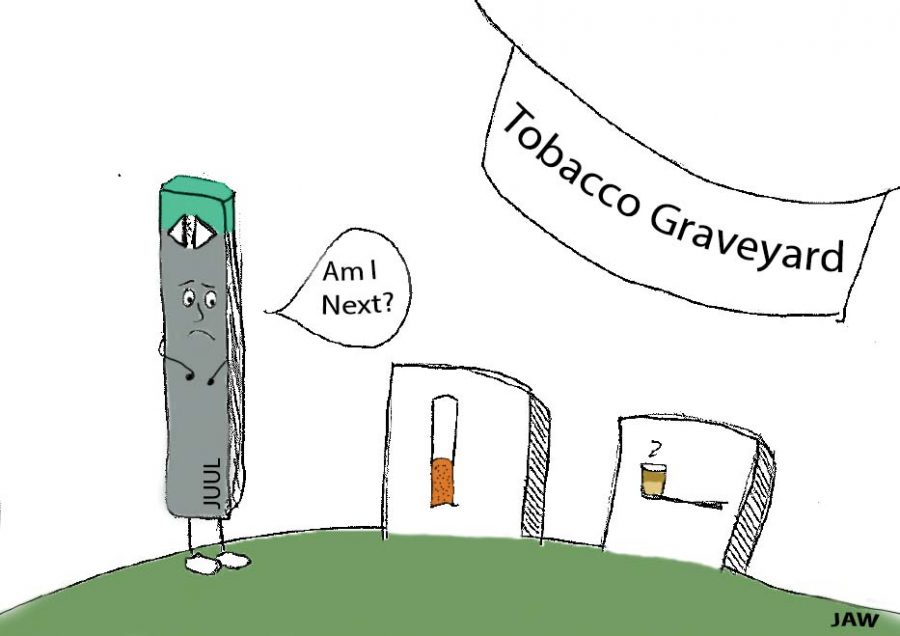The Juul Problem
In 2004, two graduate students studying design at Stanford, James Monsees and Adam Bowen, befriended each other on a smoke break. One thing the pair had in common was that they both struggled with nicotine addiction and wanted out. They came up with an idea: design a safer nicotine-delivery product as an alternative to cigarettes. They wanted to challenge the tobacco industry and shield nicotine addicts like themselves from the onslaught of health problems that come with cigarettes. Together, they designed the prototype of what would become known as a Juul.
In the early stages of the company, Juul ran an aggressive marketing campaign promoting the product. By posting pictures of young celebrities and models with vapes in hand, the company attracted young adults and teenagers in addition to long-term nicotine addicts. However, the company failed to foresee the devastating consequences of its advertising and the pervasiveness of its product.
About 25% of high-schoolers admit they have vaped, and almost 70% say they have seen someone vape in school. Less than five years after Juul Labs released its first products in 2017, almost two thousand health cases and at least thirty-eight deaths associated with vaping have been documented. Many of the cases have involved minors with no history of smoking.
Rather than a tool used to support nicotine addicts in their struggle for rehabilitation, Juul has instead attracted new users, swelling the ranks of the nicotine-addicted, and acted as a gateway drug. One in three students who vape turn to traditional cigarettes within six months.
Yet smoking among high schoolers continues to decline. So why is it that Juul continues its meteoric rise while smoking rates fall? Well, it’s a common consensus among high schoolers that “Big Tobacco” companies are dangerous and have a track record of prioritizing profits over consumer health. Consequently, many students consider the alternative, e-cigarettes like Juul, to be safe; in fact, two-thirds of students who Juul believe the only ingredients in Juul are water vapor and flavoring.
Juul Labs’s recent activity reveals the true nature of e-cigarettes: the reincarnation of Big Tobacco and corporate greed.
After facing fierce backlash by both the public and the FDA (Food & Drug Administration), Juul Labs sold over a third of the company in 2018 December to Altria – formerly known as Phillip Morrison – one of the world’s biggest tobacco manufacturers and the mastermind behind the infamous Marlboro Man. Juul Labs, created to fight against oppressive “Big Tobacco” companies, is now merging with them.
In an indication of this shift, former Juul CEO Kevin Burns resigned on September 25 after issuing a public apology to parents for the detrimental side-effects of Juul. He was swiftly replaced by K.C. Crosthwaite, a former senior executive from Altria. Crosthwaite’s arrival, as well as that of former Altria senior vice-director of regulation Jose Luis Murillo, illustrates Juul Labs’s dramatic shift.
Meanwhile, cofounders James Monsees and Adam Bowen continue to claim that Juul’s true intentions were not to target youth but instead to target struggling nicotine addicts. Regardless of the veracity of their statements, their decision to join Big Tobacco reveals them to be yet another rapacious company willing to deal with the devil in search of profits.
Here is where I’d like to call upon you, the reader, to take initiative. We have become numb to facts about the devastating side effects of vaping – from the statistics that one Juul pod contains twenty times more nicotine than a pack of cigarettes to the fact that a third of e-cigarette users turn to cigarettes. At some point, if hard facts don’t reach you, nothing will. This epidemic is no longer a matter of innocent ignorance, but deliberate denial.
And it is here that the onus falls on you, the reader, to take the first step. If adults like Mr. McKibben fail to convince the remaining members of our community who Juul to work to quit, then the only people who can influence us are ourselves.






